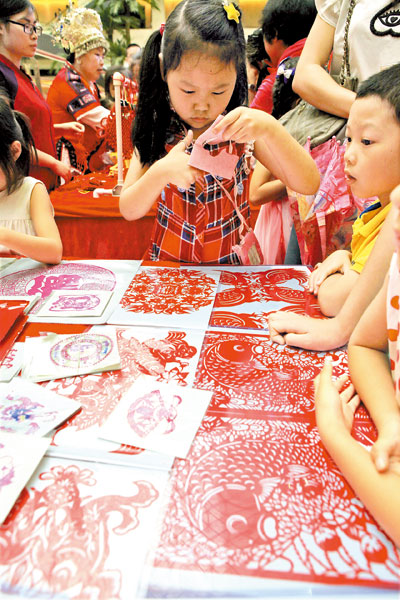
SEVERAL intangible heritage programs originating from Futian District have drawn attention at the 11th Cultural Heritage Day, which was held June 11 at Shenzhen Museum’s Civic Center outlet. The programs include traditional knitting techniques for apron strings in Shangmeilin, an ancestor worship ceremony in Xiasha, the Mo family’s lighting ceremony in Shawei, Li’s acupoint massage and Luo’s abdomen examination and massage. The ancestor worship ceremony is one of the few national-level cultural heritages recognized in Shenzhen. It is a traditional worship ceremony for the Huang family living in the Xiasha area, Futian District, which has a history of more than 800 years. Every spring and autumn, the Huang family holds the ceremony at the Huang Siming Temple in Xiasha Village and Huang Motang’s tomb at Lotus Hill. The spring worship is very simple with all family members worshiping at the temple. The autumn ceremony is a grand event with the oldest grandson alive in the family hosting the ceremony. They worship at the tomb on the Lunar Sept. 15 and at the temple the next day. The activities they do at the ceremony are rarely seen in other parts of the country. Meilin’s traditional knitting technique for apron string is a city-level intangible cultural heritage. The knitting is done by hand using colorful silk threads. Popular patterns include flowers and turtles. The technique can be traced back to the late Ming and early Qing dynasties. It was passed down between women in the village. Currently it is only practiced by a few women in Shangmeilin Village, Futian District. The 11th China’s Cultural Heritage Day is a yearly event on the second Saturday in June. In 2005, the State Council issued the Notice on Strengthening Cultural Heritage Protection, putting up specific requests on the protection of tangible and intangible cultural heritage. Organized by Futian District and Shenzhen Tianxia International Cultural Industry Co., the event features interactive activities, exhibitions, performances and lectures to showcase the country’s cultural heritage. Visitors can not only learn traditional skills at the event but can also participate in folk sports games, playing old games such as throwing sand bags, bowling hoops and kicking shuttlecocks. Other highlights include various types of traditional Chinese opera such as Kunqu opera, Beijing opera, Huangmei opera, Shaoxing opera and Cantonese opera. Historical treasure experts and archaeologists also gave free evaluations of ancient Chinese antiques or artifacts brought by visitors.(Wang Yuanyuan) | 
